engine NISSAN 300ZX 1984 Z31 Engine Fuel And Emission Control System Workshop Manual
[x] Cancel search | Manufacturer: NISSAN, Model Year: 1984, Model line: 300ZX, Model: NISSAN 300ZX 1984 Z31Pages: 79, PDF Size: 2.15 MB
Page 1 of 79

ENGINE FUEL &
- EMISSION - CONTROL SYSTEM
SECTION EFaEC
CONTENTS
PRECAUTIONS ..
COMPONENT PARTS LOCATION
ECCS DIAGRAM
. . .
ECCS CHART ..
ECC.S WIRING DIAGRAM . . ..
FUEL FLOW SYSTEM DESCRIPTION .
AIR FLOW SYSTEM DESCRIPTION ....
E C C S. DESCRIPTION . . . . ...
DIAGNOSTIC PROCEDURE . ..
SE LF-D I AGNOSIS ..
..
.. ..
..
..
..
...
ELECTRONfC CONTROL SYSTEM INSPECTION
MIXTURE RATIO FEEDBACK SYSTEM INSPECTION
. ,
FUEL SYSTEM INSPECTION
TURBOCHARGER
. ... ..
INJECTOR COOLING FAN (VG30ET) .
PRESSURE REGULATOR CONTROL
CRANKCASE EMISSION CONTROL SYSTEM
. . . .
EXHAUST EMISSION CONTROL SYSTEM . . ...
EVAPORATIVE EMISSION CONTROL SYSTEM . . .
SERVICE DATA AND SPECIFICATIONS (S DS). . . . . . .
. . EF&EC- 2
. EF&EC- 3
EF & EC- 4
EF&EC- 6
EF&EC- 8
.. EF & EC-10
EF
& EC-11
, EF&EC-13
EF
& EC-28
EF
& EC-35
EF
& EC43
EF & EC-60
EF
& EC-63
EF
& EC-66
EF
& EC-69
EF
& EC-72
. . EF & EC-74
EF
& EC-75
, EF&EC-76
EF & EC-79
Page 2 of 79
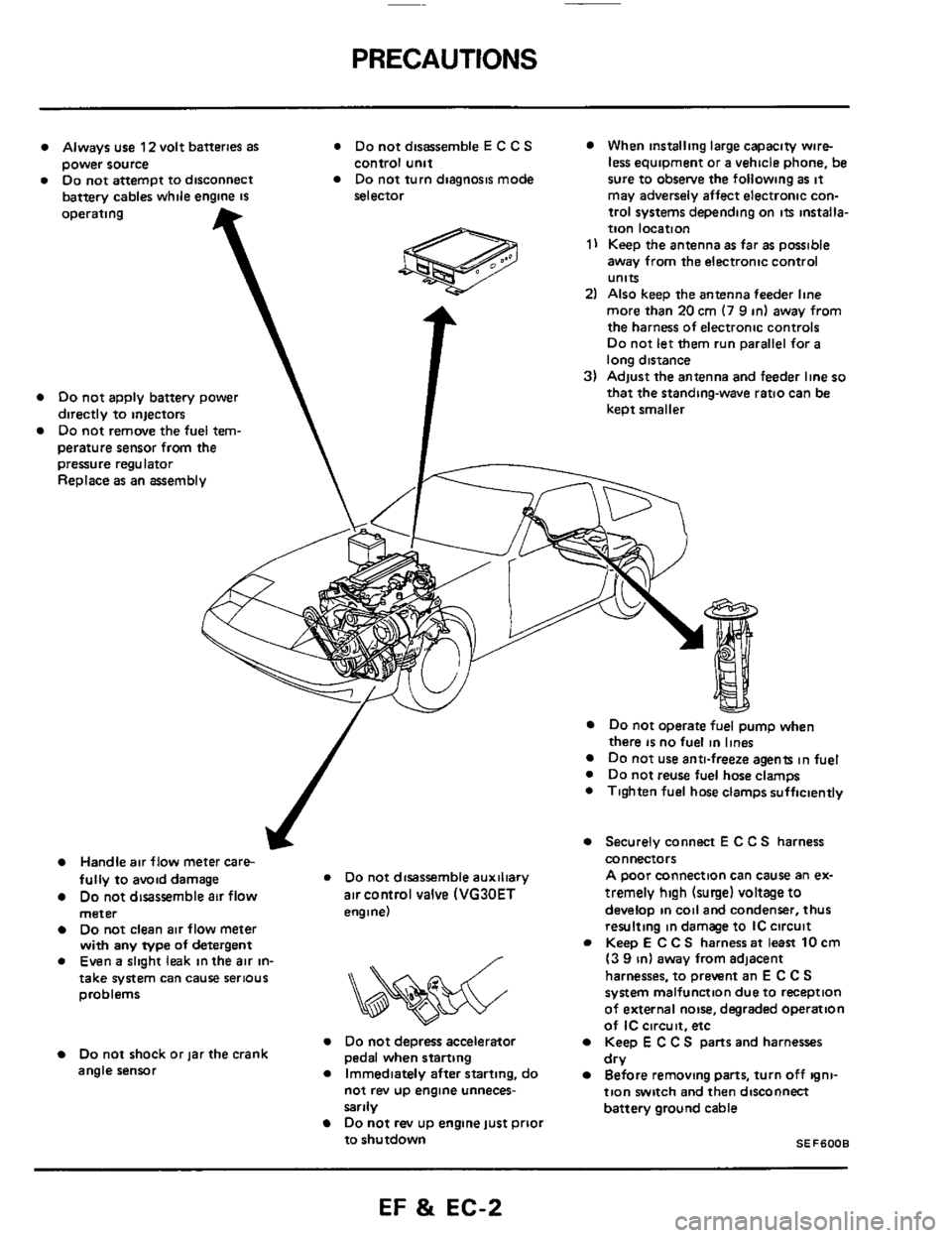
PRECAUTIONS
Always use 12 volt batteries as * Do not disassemble E C C S When installing large capacity wire-
Do not attempt to disconnect Do not turn diagnosis mode sure to obsetve the following as it power source
battery cables while engine
IS
control unit
selector less equipment or a vehicle phone, be
may adversely affect electronic con-
operating
Do not apply battery power
directly to injectors
Do not remove the fuel tem-
perature sensor from
the T
pressure regulator
Replace as an assembly
trol systems depending on its installa-
tion location
1) Keep the antenna as far as possible
away from the electronic control
units
2) Also keep the antenna feeder line
more than
20 cm (7 9 in) away from
the harness of electronic controls
Do not let them run parallel for a
long distance
3) Adjust the antenna and feeder line so
that the standing-wave ratio can be
keot smaller
J
Handle air flow meter care-
fully to avoid damage * Do not disassemble auxiliary
Do not disassemble air flow air control valve (VG30ET
meter engine)
Do not clean air flow meter
with any type of detergent
0 Even a slight leak in the air in- /
&&%$$?&
take system can cause serious
problems
Do not depress accelerator Do not shock or jar the crank
angle sensor
Immediately after starting, do
pedal when starting
not rev
up engine unneces-
sarily
Do not rev up engine just prioi
to shutdown
Do not operate fuel pump when
there is no fuel in lines Do not use anti-freeze agents in fuel
0 Do not reuse fuel hose clamps
0 Tighten fuel hose clamps sufficiently
Securely connect E C C S harness
connectors
A poor connection can cause an ex-
tremely
high (surge) voltage to
develop in coil and condenser, thus
resulting in damage to IC circuit
Keep
E C C S harness at least 10 cm
(3 9 in) away from adjacent
harnesses, to prevent an
E C C S
system malfunction due to reception
of external noise, degraded operation
of
IC circuit. etc
Keep E C C S parts and harnesses
Before removing parts, turn off igni-
tion switch and then disconnect
battery ground cable dry
SEF6008
EF & EC-2
Page 3 of 79
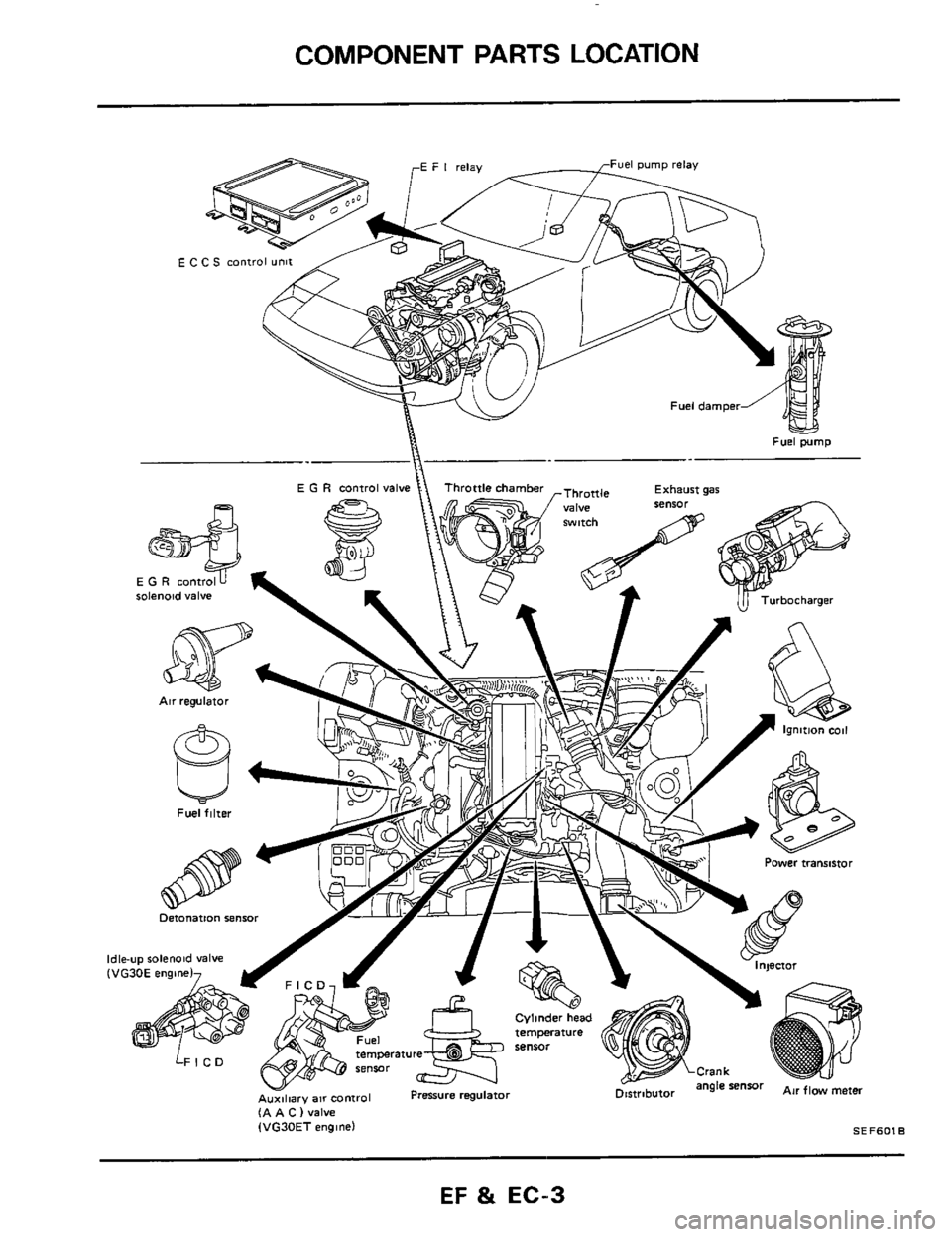
COMPONENT PARTS LOCATION
E C C S conlr01 unit
IA A C (valve (VG30ET engine) SEFBOlB
EF & EC-3
Page 4 of 79

E. C.C. S. DIAGRAM
VG30E Engine (Without turbocharger)
SEF602B
EF & EC-4
Page 5 of 79
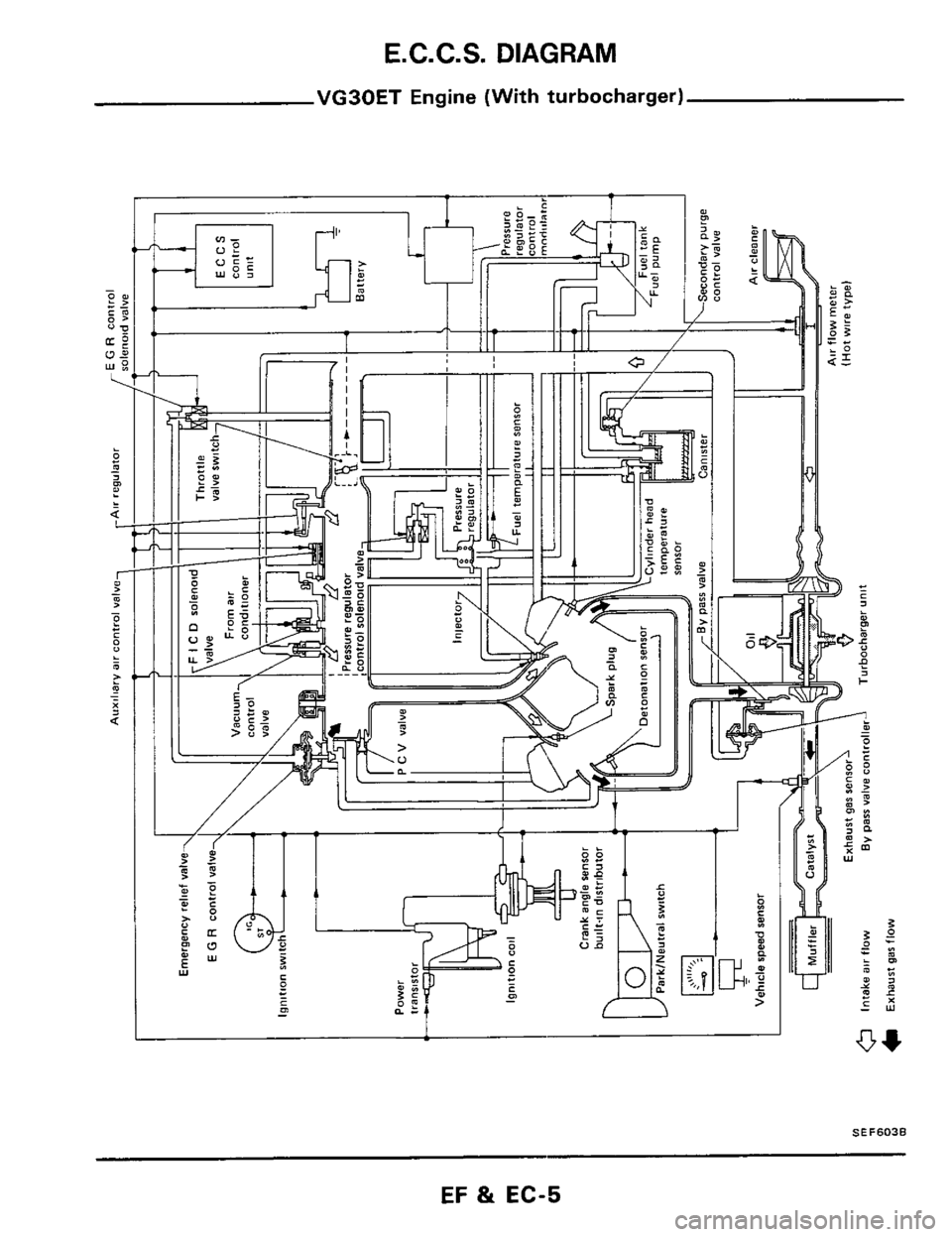
E.C.C.S. DIAGRAM
VG30ET Engine (With turbocharger)
L
SEF603B
EF & EC-5
Page 6 of 79
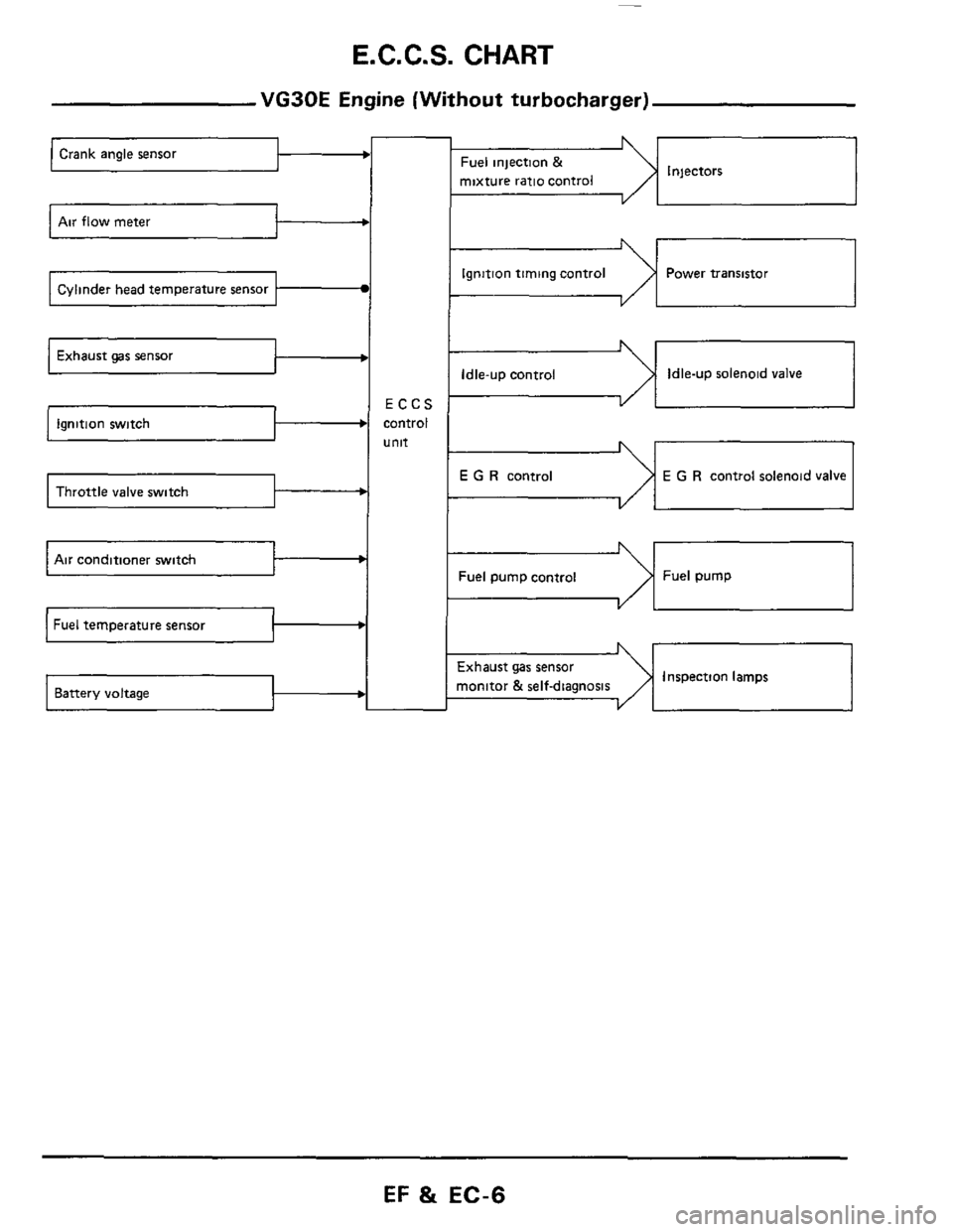
E.C.C.S. CHART
Exhaust gas sensor t
b
Throttle valve switch -b
VG30E Engine (Without turbocharger)
ECCS
control
unit
Crank angle sensor
%el pump control Fuel pump
Air conditioner switch 1 t
Battery voltage
- I
Injectors Fuel injection &
mixture ratio control
VI 1
1
Ignition timing control Power transistor
Idle-up control Idle-up solenoid valve
E G R control E G R control solenoid valve
-1 I
Inspection lamps ixhaust gas sensor
nonitor
& self-diamosis
EF & EC-6
Page 7 of 79
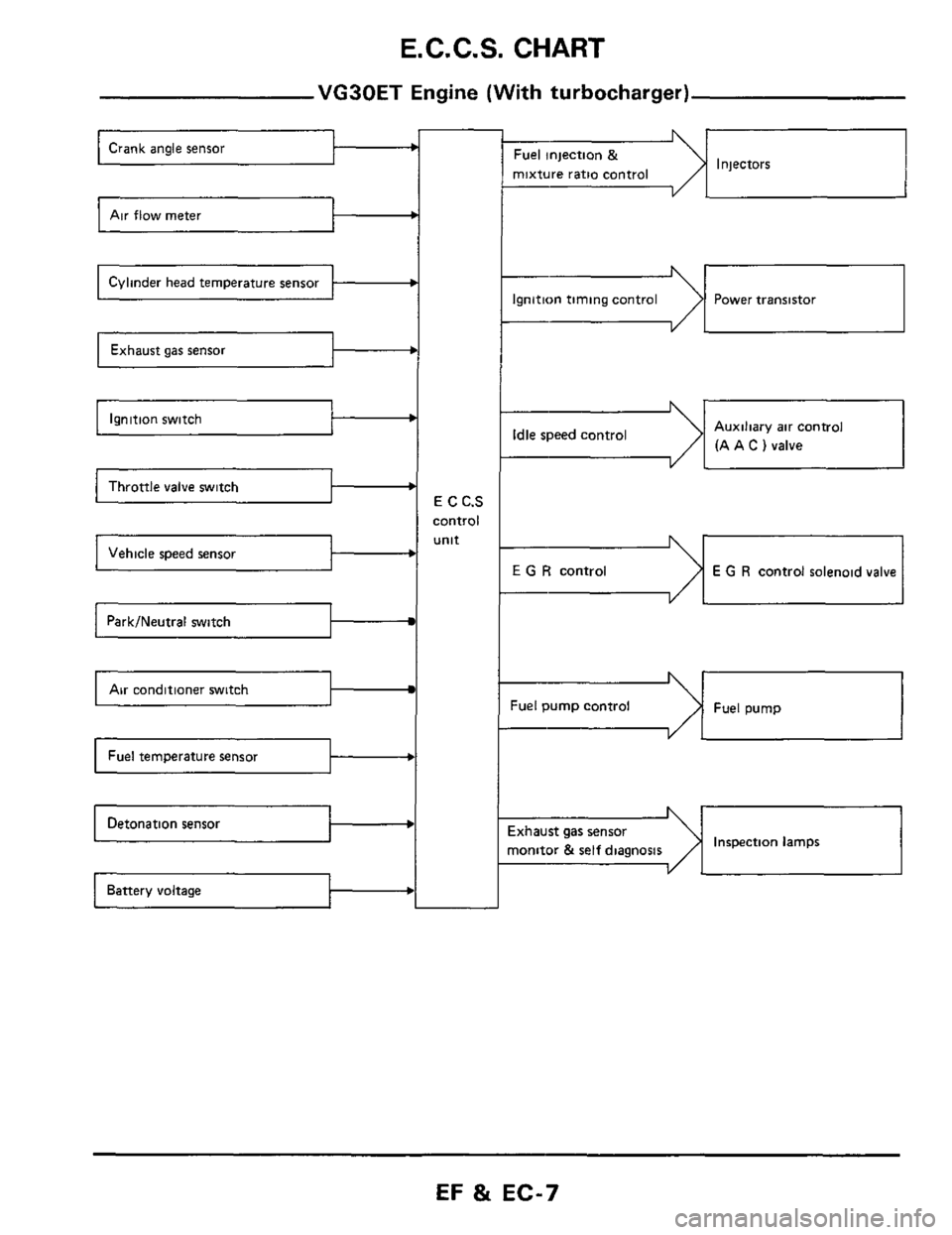
E. C. C.S. CHART
VG30ET Engine (With turbocharger)
Air flow meter c
Cylinder head temperature sensor b
b
Ignition switch b
Throttle valve switch I b
b
Park/Neutral switch
Air conditioner switch I
b
E C C.S
control
unit
b
Injectors Fuel injection &
mixture ratio control
--I
Ignition timing control Power transistor
-dI Auxiliary air control
(A A
C ) valve Idle speed control
I YL
E G R control E G R control solenoid valve
Fuel pump control Fuel pump
Inspection lamps ixhaust gas sensor
nonitor
& self diagnosis I
EF & EC-7
Page 10 of 79

FUEL FLOW SYSTEM DESCRIPTION
The amount of fuel to be injected is determined by
the injection pulse duration
as well as by a pressure
difference between fuel pressure and intake mani-
fold vacuum pressure. The
E.C C.S. control unit
controls only the injection pulse duration For this
reason,
the pressure difference between the fuel
pressure and intake manifold vacuum pressure
should be maintained
at a constant level Since the
intake manifold vacuum pressure varies with engine
operating conditions,
a pressure regulator IS placed
in the fuel line to regulate the fuel pressure in
response to changes
in the intake manifold vacuum
pressure
Fuel pump and damper
’ iFueirank
SEF604B
intake manifold 0 vacuum
a From fuel tank
Fuel chamber
SEF605B
Fuel presswe
EF & EC-10
Page 11 of 79
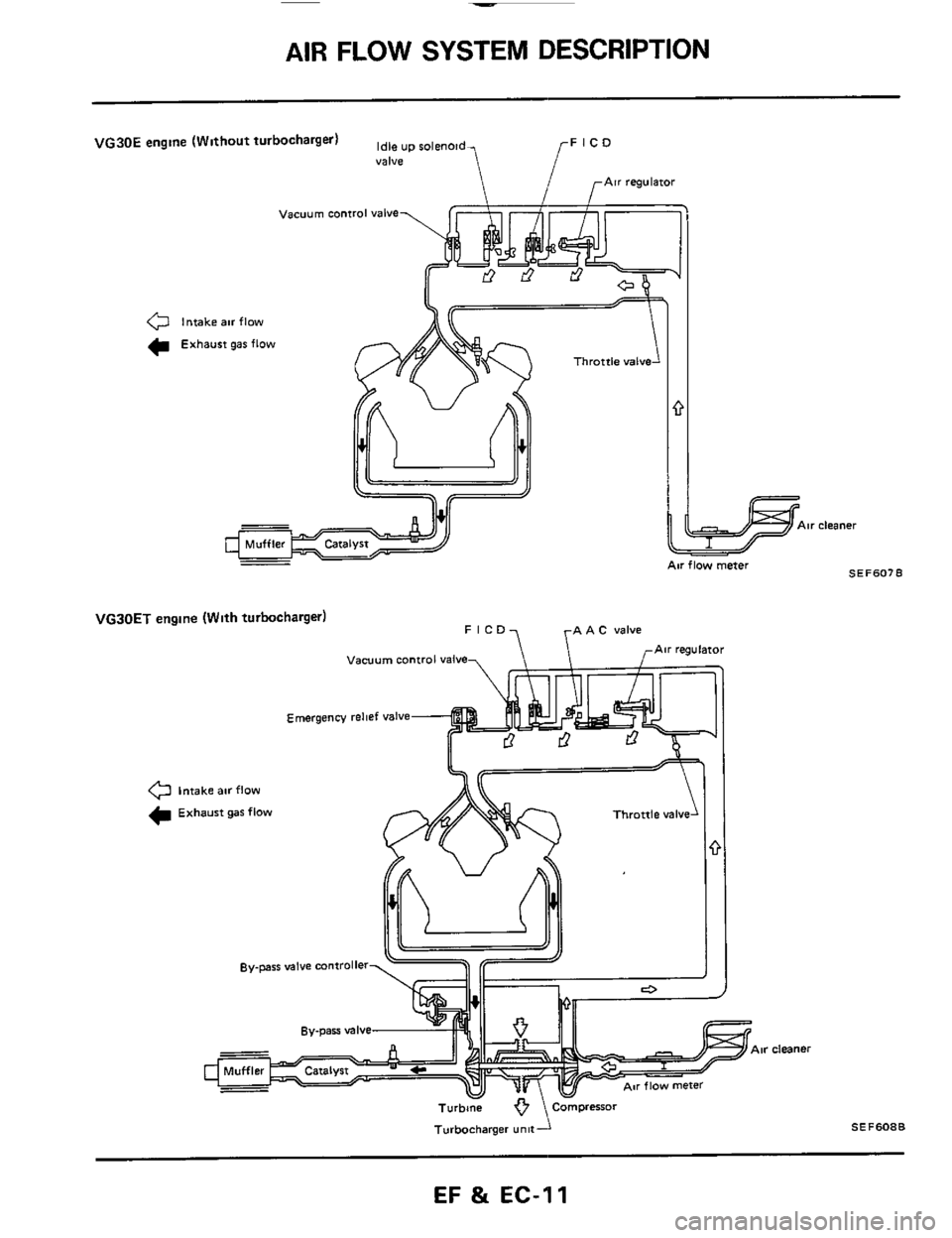
AIR FLOW SYSTEM DESCRIPTION
Air cleaner
VG30E engine (Without turbocharger) up roleno,,, FlCD
r
Valve
0 Intake air flow
C Exhaust gar flow
VGJOET engine (With turbocharger)
Vacuum control valve
Emergency relief valve
0 Intake air flow
Exhaust gar flow
cleaner
Turbbne
Turbocharger - unit- \Compresor SE F 608 B
EF & EC-11
Page 12 of 79
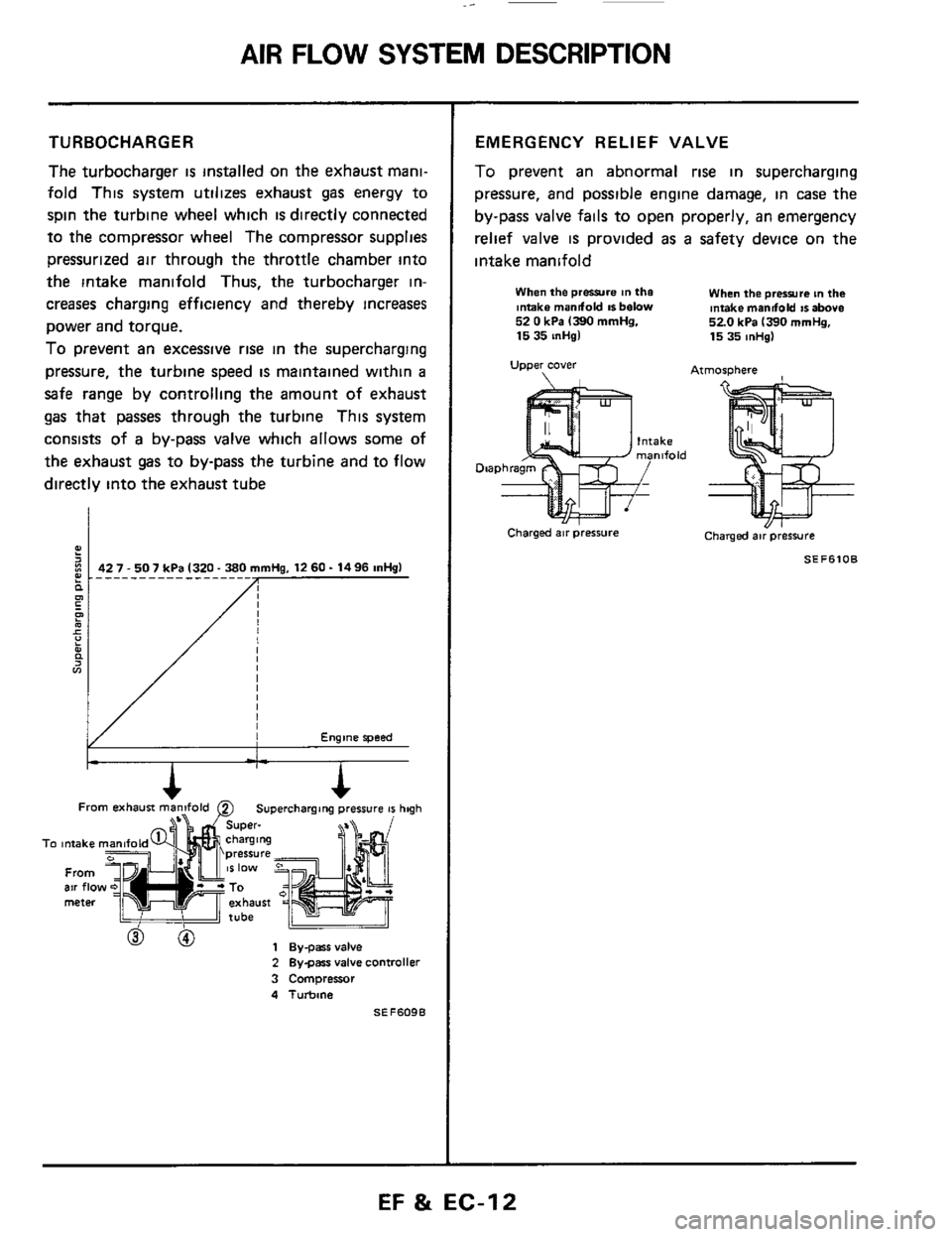
AIR FLOW SYSTEM DESCRIPTION
TURBOCHARGER
The turbocharger is installed on the exhaust mani-
fold This system utilizes exhaust gas energy to
spin the turbine wheel which
is directly connected
to the compressor wheel The compressor supplies
pressurized air through the throttle chamber into
the intake manifold Thus, the turbocharger in-
creases charging efficiency and thereby increases
power and torque.
To prevent an excessive rise in the supercharging
pressure, the turbine speed
is maintained within a
safe range by controlling the amount of exhaust
gas that passes through the turbine This system
consists of
a by-pass valve which allows some of
the exhaust gas to by-pass the turbine and to flow
directly into the exhaust tube
Engine speed
From b==iF exhausi man2fold 0 Superchargang pressure 41 hqh
To intake
From air flo meter
h
To intake
From air flo meter
2 Bygars valve controller
3 Compressor
4 Turbine
SEF609B
EMERGENCY RELIEF VALVE
To prevent an abnormal rise in supercharging
pressure, and possible engine damage, in case
the
by-pass valve fails to open properly, an emergency
relief valve
is provided as a safety device on the
intake manifold
When the prwre in the Intake mandold IS below 52 0 kPa 1390 mmHg. 15 35 inHgl
Upper cover
When the prerrura tn the intake mandold IS above 520 kPa 1390 mrnHg, 15 35 mHg)
Atmosphere
Charged air pressure Charged air pressure
SEF6lOB
EF & EC-12